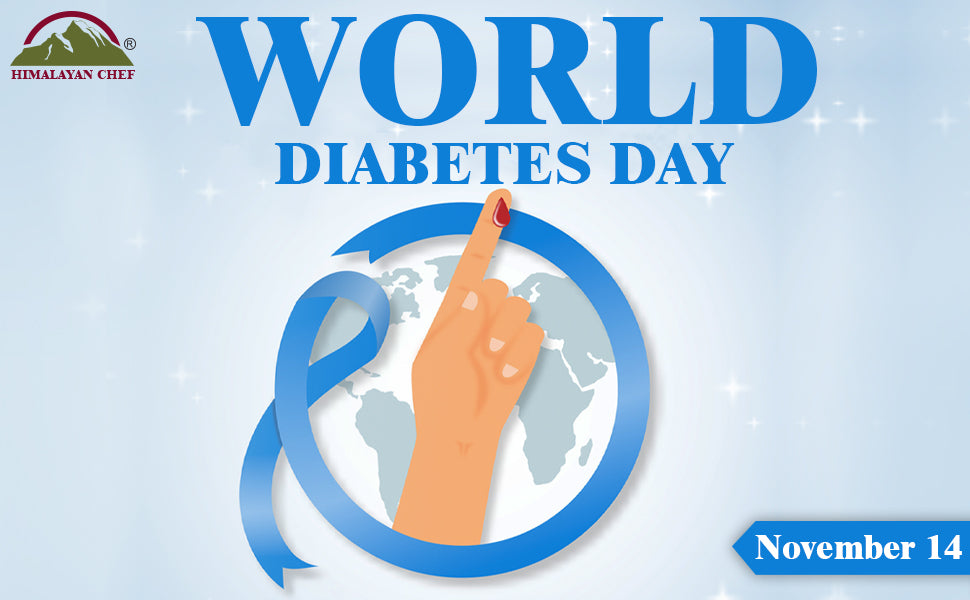From Awareness to Action: A Guide to Proactive Diabetes Management on World Diabetes Day
Posted by HIMALAYAN CHEF

World Diabetes Day serves as a crucial reminder to raise awareness about diabetes, a chronic condition affecting millions worldwide. In this comprehensive guide, we delve into the intricacies of diabetes, exploring its types, risk factors, symptoms, major health complications, dietary considerations, and lifestyle modifications for managing the condition.

What is Diabetes?
Diabetes is a metabolic disorder characterized by elevated blood glucose levels, commonly referred to as blood sugar. The body's inability to produce or effectively use insulin, a hormone that regulates blood sugar, leads to this condition. There are primarily three types of diabetes: Type 1, Type 2, and gestational diabetes.

Type 1 Diabetes
Occurs when the immune system mistakenly attacks and destroys insulin-producing beta cells in the pancreas.
Typically diagnosed in childhood or adolescence.
Requires insulin injections for blood sugar management.
Type 2 Diabetes
Results from insulin resistance or insufficient insulin production.
Often linked to lifestyle factors like poor diet and lack of physical activity.
Can be managed with lifestyle changes, oral medications, or insulin.
Gestational Diabetes:
Develops during pregnancy and increases the risk of Type 2 diabetes later in life.
Blood sugar levels usually return to normal after childbirth.

Understanding the risk factors is crucial for prevention and early detection
Prevention: Knowing the risk factors allows individuals to adopt preventive measures. For example, by understanding that a sedentary lifestyle is a risk factor, one might be motivated to engage in regular physical activity to reduce the likelihood of developing diabetes.
Early Detection: Recognizing risk factors enables early detection through regular health check-ups and monitoring. Identifying diabetes in its early stages allows for timely intervention and management.
Lifestyle factors such as sedentary behavior, unhealthy diet, and obesity play a significant role
Sedentary Behavior: Lack of physical activity or prolonged periods of sitting can contribute to insulin resistance, a key factor in the development of type 2 diabetes.
Unhealthy Diet: Diets high in processed foods, sugars, and unhealthy fats can contribute to obesity and insulin resistance, increasing the risk of diabetes.
Obesity: Excess body weight, especially around the abdomen, is strongly associated with an increased risk of diabetes.
Additionally, genetic predisposition, age, and certain medical conditions contribute to the risk of developing diabetes
Genetic Predisposition: A family history of diabetes can increase an individual's susceptibility. Genetic factors can influence how the body regulates glucose.
Age: The risk of diabetes tends to increase with age. This is partly because older individuals may be more likely to develop insulin resistance and other risk factors.
Certain Medical Conditions: Conditions such as polycystic ovary syndrome (PCOS), high blood pressure, and gestational diabetes can increase the risk.

Increased Hunger: Individuals with diabetes may experience persistent feelings of hunger, even after eating.
Slow Healing of Wounds: Wounds, cuts, or sores may take longer to heal than usual.
Tingling or Numbness: Numbness or tingling sensations, especially in the hands and feet, can be a sign of nerve damage.
Recurrent Infections: Diabetes can weaken the immune system, leading to frequent infections, especially in the skin, gums, or urinary tract.
Irritability: Fluctuations in blood sugar levels can affect mood, leading to irritability or mood swings.
Dry Skin and Itching: Diabetes can cause dry skin and itching, particularly in the extremities.
Yeast Infections: Women with diabetes may experience more frequent yeast infections.
Increased Fatigue: Persistent fatigue or a feeling of being tired, even after getting enough rest, can be a symptom of diabetes.
Breath Odor: Sweet or fruity breath odor may occur, especially in cases of uncontrolled diabetes.

Diabetes can lead to various health complications, affecting different organs and systems in the body. The major complications include:
Cardiovascular Disease:
Diabetes increases the risk of heart disease and stroke. High blood sugar levels, along with other factors like high blood pressure and abnormal cholesterol levels, contribute to cardiovascular complications.
Prevention and Management: Lifestyle modifications, including a healthy diet, regular exercise, and medications for blood pressure and cholesterol control, are essential for preventing cardiovascular complications.
Retinopathy:
Diabetic retinopathy is a condition that affects the eyes. It involves damage to the blood vessels in the retina, leading to vision impairment and, in severe cases, blindness.
Prevention and Management: Regular eye exams, blood sugar control, and sometimes laser therapy or surgery are essential for managing diabetic retinopathy.
Nephropathy:
Diabetic nephropathy refers to kidney damage caused by diabetes. It can lead to kidney failure over time.
Prevention and Management: Blood pressure control, blood sugar management, and medications to protect the kidneys are crucial. In severe cases, dialysis or kidney transplantation may be necessary.
Neuropathy:
Diabetic neuropathy is nerve damage that can occur in various parts of the body, leading to symptoms such as numbness, tingling, and pain.
Prevention and Management: Strict blood sugar control, pain management, and lifestyle adjustments are key components of preventing and managing diabetic neuropathy.
Peripheral Artery Disease (PAD):
Diabetes increases the risk of peripheral artery disease, which involves the narrowing of blood vessels, particularly in the legs. This can lead to poor circulation and, in severe cases, amputation.
Prevention and Management: Lifestyle changes, including smoking cessation, regular exercise, and blood sugar control, can help prevent and manage PAD.
Foot Complications:
Diabetes can lead to foot problems, including infections, ulcers, and poor wound healing. In severe cases, this may result in amputation.
Prevention and Management: Regular foot care, wearing appropriate footwear, and managing blood sugar levels are essential for preventing diabetic foot complications.
Infections:
People with diabetes are more susceptible to infections. Poorly controlled diabetes can impair the immune system's function.
Prevention and Management: Vaccinations, good hygiene, and prompt management of any infections are crucial for individuals with diabetes.

Foods that Help Reduce the Risk of Diabetes:
Whole Grains:
Description: Whole grains such as brown rice, quinoa, and whole wheat provide essential nutrients like fiber, vitamins, and minerals.
Benefits: The fiber content helps regulate blood sugar levels by slowing down the absorption of glucose, promoting better glycemic control.
Fruits and Vegetables:
Description: Fruits and vegetables are rich in antioxidants, vitamins, and fiber.
Benefits: Antioxidants help combat inflammation, and the fiber content aids in maintaining steady blood sugar levels. The overall nutrient profile promotes general health.
Healthy Fats:
Description: Sources of healthy fats include avocados, nuts, seeds, and olive oil.
Benefits: Healthy fats support heart health and can help improve insulin sensitivity, contributing to better blood sugar control.
Foods to Avoid
Added Sugars:
Description: Sugary beverages, desserts, and processed foods often contain added sugars.
Rationale: Excessive sugar intake can lead to insulin resistance, contributing to the development of diabetes. Limiting added sugars supports better blood sugar management.
Refined Carbohydrates:
Description: Refined carbohydrates include white bread, pasta, and sugary cereals.
Rationale: These carbohydrates can cause rapid spikes in blood sugar levels. Choosing wole grains over refined options helps maintain more stable blood sugar levels.
Trans Fats:
Description: Trans fats are found in partially hydrogenated oils present in some processed foods.
Rationale: Trans fats contribute to inflammation and insulin resistance, increasing the risk of diabetes. Avoiding foods with trans fats supports overall health.
Lifestyle Modifications for Diabetic Patients
Regular Exercise:
Description: Aerobic exercises (e.g., walking, cycling) and strength training improve insulin sensitivity.
Benefits: Regular exercise helps manage blood sugar levels, enhances overall cardiovascular health, and supports weight management.
Balanced Diet:
Description: A balanced, low-glycemic diet includes a variety of nutrient-dense foods with proper portion control.
Benefits: Such a diet promotes stable blood sugar levels, aids in weight management, and provides essential nutrients for overall health.
Regular Monitoring:
Description: Regularly monitoring blood sugar levels helps individuals understand how different foods and activities impact their diabetes management.
Benefits: This allows for timely adjustments to treatment plans, ensuring better control of blood sugar levels.
Stress Management:
Description: Stress management techniques, such as mindfulness and relaxation exercises, can help mitigate the impact of stress on blood sugar.
Benefits: Lowering stress levels contributes to improved overall well-being and better blood sugar control in individuals with diabetes.
Conclusion:
On World Diabetes Day, let us unite in the effort to raise awareness about diabetes prevention, early detection, and effective management. Armed with knowledge about the types, risk factors, symptoms, and lifestyle modifications, individuals can make informed choices to lead a healthier life, reducing the global burden of diabetes
TAGS:
SHARE:


